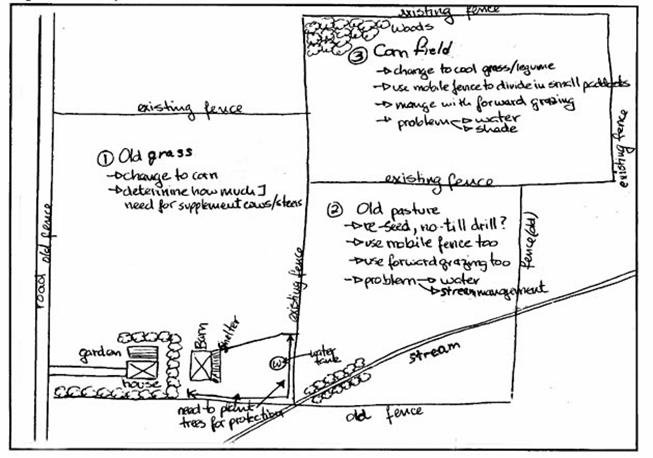Assessment of Resources
(Lesson 1. Planning a Grazing System continued)
Inventory
Start by making a list of your resources and their condition.
- Personnel time available, interests
- Animals by species, condition and biological stage
- Feed and forage
- Land resources: owned and rented
- Wildlife
Map
Get an aerial picture of your farm, or a map of your land from the Natural Resources Conservation Service (NRCS), and draw the items such as buildings, shelters, fences, lanes, water points, wooded areas, etc. You can get soil maps at the same time, as they will also provide useful information to make informed decisions on pasture management. Number each field and write notes of changes needed (See Figure 1).
Figure 1. Map of farm with notes of fields, buildings, facilities and natural resources.

The local Farm Service Agency Office can provide actual field measurements using aerial photographs and their planimeter (electronic measurement device).
Condition of Pastures and Fields
Once you have drawn the farm map, research the present condition of the farm by getting information and making notes about each pasture or field. You can use some of the monitoring tools explained later in this lesson.
| Measurements to be taken | Decision to be made | Cost information |
|---|---|---|
| Land area | How much into pasture or other crops? | Renting vs. buying |
| Length and condition of existing fences | Type of fence to use | Fence and fencing supplies |
| Condition of existing watering system | Type of tanks and lines or ponds | Well, water line, and tank |
| Pasture composition, condition and productivity | Kind of pasture mix to use: cool and warm season grasses, legumes | Tillage, seed, and seeding. Herbicides and application |
| Soil characteristics | Kind of nutrients to use: fertilizer purchase, manure, compost | Fertilizer and application |
| Condition of existing machinery | What equipment is really needed? Till, no-till, animal impact | Repairs, new equipment, rental |
